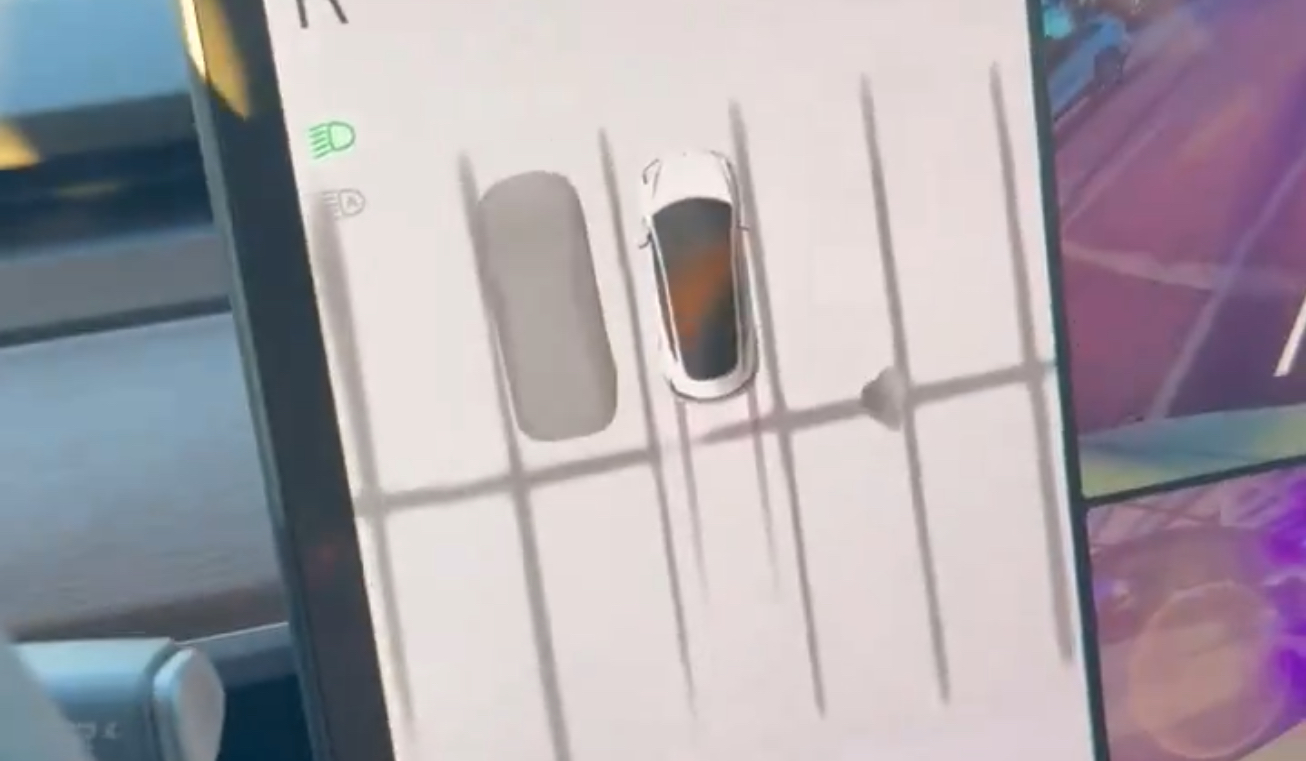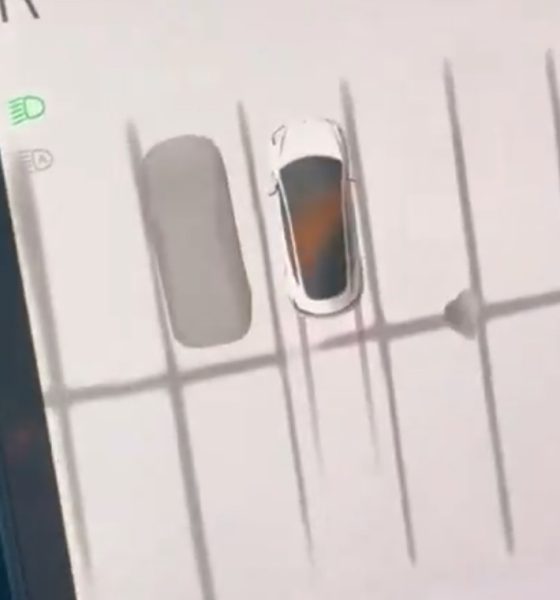Release notes for Tesla’s holiday software update were shared earlier this month, including the addition of the High Fidelity Park Assist feature. Some have since shared footage of the feature in action, showing how it works in parking lots and garages as users evaluate its usefulness when trying to park.
Tesla’s holiday update release notes were shared on X earlier this month, where the company first mentioned the new High Fidelity Park Assist mode. Tesla owner Ryan Hoffman, along with others, have shared videos of the feature on X, including one taken in a Supercharger lot on Saturday.
As can be seen in the video, the activated High Fidelity Park Assist mode shows a similar view to the highly requested Birds Eye 360-degree visualization. Hoffman says he drives a 2023 Model 3 RWD with HW3 and the Ryzen chip, meaning the car doesn’t have Ultrasonic Sensors (USS) and utilizes just Tesla Vision.
The video is taken at a Supercharger station, where Hoffman backs into a charging spot. Behind the visualization of the car, you can see an orange and yellow zone, signifying the vehicle’s close proximity to the charging pile. The top-down visualization shows that it recognizes the charging stalls as well as the parking lines on the ground, making it easy to back into the spot without the car ending up crooked.
He also shared a short video of what it looks like to back into the spot, including the actual rear camera’s video footage and the High Fidelity Park Assist view, and calling the feature a “game changer” for parking.
Here’s a short video of what it looked like to reverse into the spot. The lines for each parking spot are very handy… it’s a game changer for parking. pic.twitter.com/47BDBbXw7z
— Ryan Hoffman (@tekmaven) December 16, 2023
Others have shared similar footage of High Fidelity Park Assist, as many have wondered how exactly the feature is activated when being used in a parking lot. According to X user EVBaymax, the feature appears to engage when there is a clearly defined object in front of or around the car, and when users shift into reverse in a parking lot. Still, the current version seems to lack the ability to engage when driving forward, although it probably should have this ability.
In his videos of the feature, you can see the visualization switch on from the regular Autopilot view when reversing in the parking lot, and he also says that speeding up to around 15-20 mph makes the visualization disappear again. He goes on to call the feature “surprisingly accurate” and “definitely helpful,” and he also includes footage using it in a darker, in-garage environment.
Here’s what the switch from Autopilot visualizations to High-Fidelity Park Assist looks like in a parking lot pic.twitter.com/xtx8BylI0W
— kEV (@EVBaymax) December 16, 2023
You can see in the above videos that the feature still requires some prodding to work as desired, though once it’s engaged, it looks to be pretty useful. It does, however, appear to fill the need that many have requested with Birds Eye, 360-degree views, as the top-down visualizer makes it especially easy to see where the vehicle is in relation to other cars, parking lines, and more when parking.
Tesla CEO Elon Musk recently said that the company’s cars will eventually offer a convenient “Tap to Park” feature, in which the vehicle will identify open parking spots and let drivers select on-screen which to use, then letting the driver get out and allow the car to park itself in the selected space. Still, many are awaiting updates like Tesla’s Actually Smart Summon and the automaker only reintroduced its Vision-based Park Assist earlier this year.
Tesla Model 3 Highland owner’s manual confirms Auto Shift out of Park feature
What are your thoughts? Let me know at zach@teslarati.com, find me on X at @zacharyvisconti, or send your tips to us at tips@teslarati.com.

News
Elon Musk’s Grokipedia surges to 5.6M articles, almost 79% of English Wikipedia
The explosive growth marks a major milestone for the AI-powered online encyclopedia, which was launched by Elon Musk’s xAI just months ago.

Elon Musk’s Grokipedia has grown to an impressive 5,615,201 articles as of today, closing in on 79% of the English Wikipedia’s current total of 7,119,376 articles.
The explosive growth marks a major milestone for the AI-powered online encyclopedia, which was launched by Elon Musk’s xAI just months ago. Needless to say, it would only be a matter of time before Grokipedia exceeds English Wikipedia in sheer volume.
Grokipedia’s rapid growth
xAI’s vision for Grokipedia emphasizes neutrality, while Grok’s reasoning capabilities allow for fast drafting and fact-checking. When Elon Musk announced the initiative in late September 2025, he noted that Grokipedia would be an improvement to Wikipedia because it would be designed to avoid bias.
At the time, Musk noted that Grokipedia “is a necessary step towards the xAI goal of understanding the Universe.”
Grokipedia was launched in late October, and while xAI was careful to list it only as Version 0.1 at the time, the online encyclopedia immediately earned praise. Wikipedia co-founder Larry Sanger highlighted the project’s innovative approach, noting how it leverages AI to fill knowledge gaps and enable rapid updates. Netizens also observed how Grokipedia tends to present articles in a more objective manner compared to Wikipedia, which is edited by humans.
Elon Musk’s ambitious plans
With 5,615,201 total articles, Grokipedia has now grown to almost 79% of English Wikipedia’s article base. This is incredibly quick, though Grokipedia remains text-only for now. xAI, for its part, has now updated the online encyclopedia’s iteration to v0.2.
Elon Musk has shared bold ideas for Grokipedia, including sending a record of the entire knowledge base to space as part of xAI’s mission to preserve and expand human understanding. At some point, Musk stated that Grokipedia will be renamed to Encyclopedia Galactica, and it will be sent to the cosmos.
“When Grokipedia is good enough (long way to go), we will change the name to Encyclopedia Galactica. It will be an open source distillation of all knowledge, including audio, images and video. Join xAI to help build the sci-fi version of the Library of Alexandria!” Musk wrote, adding in a later post that “Copies will be etched in stone and sent to the Moon, Mars and beyond. This time, it will not be lost.”
News
Tesla Model 3 becomes Netherlands’ best-selling used EV in 2025
More than one in ten second-hand electric cars sold in the country last year was a Tesla Model 3.

The Tesla Model 3 became the most popular used electric car in the Netherlands in 2025, cementing its dominance well beyond the country’s new-car market.
After years at the top of Dutch EV sales charts, the Model 3 now leads the country’s second-hand EV market by a wide margin, as record used-car purchases pushed electric vehicles further into the mainstream.
Model 3 takes a commanding lead
The Netherlands recorded more than 2.1 million used car sales last year, the highest level on record. Of those, roughly 4.8%, or about 102,000 vehicles, were electric. Within that growing segment, the Tesla Model 3 stood far ahead of its competitors.
In 2025 alone, 11,338 used Model 3s changed hands, giving the car an 11.1% share of the country’s entire used EV market. That means more than one in ten second-hand electric cars sold in the country last year was a Tesla Model 3, Auto Week Netherlands reported. The scale of its lead is striking: the gap between the Model 3 and the second-place finisher, the Volkswagen ID3, is more than 6,700 vehicles.
Rivals trail as residual values shape rankings
The Volkswagen ID.3 ranked a distant second, with 4,595 used units sold and a 4.5% market share. Close behind was the Audi e-tron, which placed third with 4,236 registrations. As noted by Auto Week Netherlands, relatively low residual values likely boosted the e-tron’s appeal in the used market, despite its higher original price.
Other strong performers included the Kia Niro, the Tesla Model Y, and the Hyundai Kona, highlighting continued demand for compact and midsize electric vehicles with proven range and reliability. No other model, however, came close to matching the Model 3’s scale or market presence.
News
Tesla Model Y Standard Long Range RWD launches in Europe
The update was announced by Tesla Europe & Middle East in a post on its official social media account on X.

Tesla has expanded the Model Y lineup in Europe with the introduction of the Standard Long Range RWD variant, which offers an impressive 657 km of WLTP range.
The update was announced by Tesla Europe & Middle East in a post on its official social media account on X.
Model Y Standard Long Range RWD Details
Tesla Europe & Middle East highlighted some of the Model Y Standard Long Range RWD’s most notable specs, from its 657 km of WLTP range to its 2,118 liters of cargo volume. More importantly, Tesla also noted that the newly released variant only consumes 12.7 kWh per 100 km, making it the most efficient Model Y to date.
The Model Y Standard provides a lower entry point for consumers who wish to enter the Tesla ecosystem at the lowest possible price. While the Model 3 Standard is still more affordable, some consumers might prefer the Model Y Standard due to its larger size and crossover form factor. The fact that the Model Y Standard is equipped with Tesla’s AI4 computer also makes it ready for FSD’s eventual rollout to the region.
Top Gear’s Model Y Standard review
Top Gear‘s recent review of the Tesla Model Y Standard highlighted some of the vehicle’s most notable features, such as its impressive real-world range, stellar infotainment system, and spacious interior. As per the publication, the Model Y Standard still retains a lot of what makes Tesla’s vehicles well-rounded, even if it’s been equipped with a simplified interior.
Top Gear compared the Model Y Standard to its rivals in the same segment. “The introduction of the Standard trim brings the Model Y in line with the entry price of most of its closest competition. In fact, it’s actually cheaper than a Peugeot e-3008 and costs £5k less than an entry-level Audi Q4 e-tron. It also makes the Ford Mustang Mach-E look a little short with its higher entry price and worse range,” the publication wrote.










